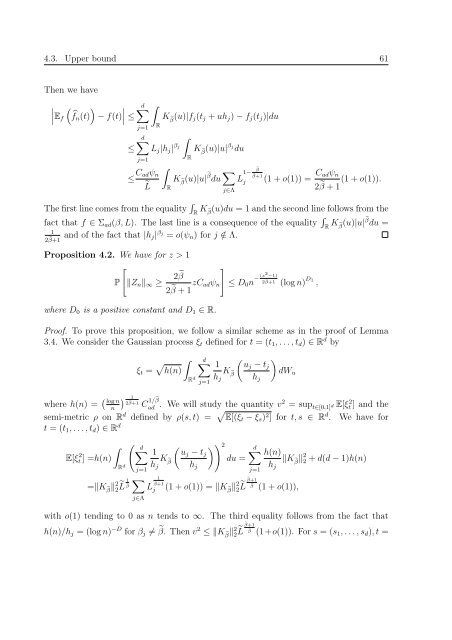THÈSE DE DOCTORAT DE L'UNIVERSITÉ PARIS 6 Spécialité ...
THÈSE DE DOCTORAT DE L'UNIVERSITÉ PARIS 6 Spécialité ...
THÈSE DE DOCTORAT DE L'UNIVERSITÉ PARIS 6 Spécialité ...
- No tags were found...
You also want an ePaper? Increase the reach of your titles
YUMPU automatically turns print PDFs into web optimized ePapers that Google loves.
4.3. Upper bound 61Then we have( )∣∣E f ̂fn (t)− f(t) ∣ ≤≤d∑∫j=1RK˜β(u)|f j (t j + uh j ) − f j (t j )|dud∑∫L j |h j | β jj=1≤ C adψ n˜L∫RK˜β(u)|u| β jduRK˜β(u)|u|˜βdu ∑ j∈ΛL 1− ˜β˜β+1j(1 + o(1)) = C adψ n(1 + o(1)).2˜β + 1The first line comes from the equality ∫ R K˜β(u)du = 1 and the second line follows from thefact that f ∈ Σ ad (β, L). The last line is a consequence of the equality ∫ R K˜β(u)|u|˜βdu =12˜β+1 and of the fact that |h j| β j= o(ψ n ) for j /∈ Λ.Proposition 4.2. We have for z > 1[]P ‖Z n ‖ ∞ ≥2˜β2˜β + 1 zC adψ n ≤ D 0 n − (z2 −1)2 ˜β+1 (log n)D 1,where D 0 is a positive constant and D 1 ∈ R.Proof. To prove this proposition, we follow a similar scheme as in the proof of Lemma3.4. We consider the Gaussian process ξ t defined for t = (t 1 , . . . , t d ) ∈ R d bywhere h(n) = ( ) 1log nnξ t = √ ∫h(n)R d2 ˜β+1 C 1/˜βadd∑j=1( )1 uj − t jK˜βdW uh j h j. We will study the quantity v2 = sup t∈[0,1] d E[ξ 2 t ] and thesemi-metric ρ on R d defined by ρ(s, t) = √ E[(ξ t − ξ s ) 2 ] for t, s ∈ R d . We have fort = (t 1 , . . . , t d ) ∈ R d∫ ( d∑E[ξt 2 ] =h(n)R d j=1∑=‖K˜β‖ 2 2˜L 1˜βj∈Λ( ) ) 21 uj − t jK˜βdu =h j h jL1˜β+1jd∑j=1(1 + o(1)) = ‖K˜β‖ 2 ˜β+1˜β2˜L (1 + o(1)),h(n)h‖K˜β‖ 2 2 + d(d − 1)h(n)jwith o(1) tending to 0 as n tends to ∞. The third equality follows from the fact thath(n)/h j = (log n) −D for β j ≠ ˜β. Then v 2 ≤ ‖K˜β‖ 2 2˜L˜β+1˜β (1+o(1)). For s = (s1 , . . . , s d ), t =










